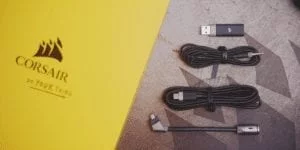Corsair Virtuoso Review – ALMOST The Best Wireless Gaming Headset!

Share:
Well hello good people, I’m Dmitri and welcome to my review of the new Corsair Virtuoso RGB Wireless gaming headset. This headset has a legitimately fancy microphone, built-in RGB LED lighting, and one heck of a name, so let’s find out if it’s any good.
There are two variants of this headset, the $219 USD SE or Special Edition version with aluminum sides and then there’s the non-SE model that is $40 USD cheaper. The three main differences between the two include a bigger microphone, aluminum side plates instead of nasty glossy plastic, and a carry pouch is included with the SE. The RGB LED lighting on the sides is free, of course.
Build Quality & Comfort
I have to give Corsair props for such a well-built headset. It’s very simple with aluminum joints, sturdy size extensions that are numbered, and there isn’t even Corsair text on the headband like we usually see. The only branded thing is the Corsair logo cutout on the sides. On the SE they have machined these micro-perforations into the aluminium ear cups to allow the RGB lighting to shine through. They look like pixels and it’s very unique. The non-SE has more traditional illumination, but it is much brighter. Both headsets offer the usual full colour palette to choose from. The problem with these micro-perforations is the potentially for dirt clog up, because the holes are so tiny. The dirt ends up finding its way into the center and clogs up those tiny holes and there is no way to really clean them. You could turn off the illumination by lowering brightness to zero in the settings, but this is an example of a testing gone wrong during the design process. However, I do appreciate their commitment to cohesive design elements across the USB dongle, the USB Type-C cable, and the chunky microphone with that awesome dotted pattern.
Now comfort-wise the headset is pretty light, and it doesn’t have excessive clamping force so glasses are not an issue. I do like the low profile rotation of the ear cups so they can rest on your neck. It’s super useful for a wireless pair. The padding is memory foam-like, unfortunately the driver wall is completely flat and not angled or curved in any way to avoid contact with your ears. So for me both ears are making contact with that internal wall, therefore wearing this headset is not very comfortable. The good thing is the clamping force is pretty neutral, so it’s not pressing against my ears, but I still prefer thicker padding or some sort of curved or angled section on that internal wall.
Controls & Ports & Microphones
Now for controls we have a smooth volume wheel with great resistance. Below that is the wired or wireless switch that also acts as your power button when in the latter position. On the opposite side is the USB Type-C port that is used for charging or when using the headset in wired mode. There is also a 3.5mm analog port to use with controllers or smartphones. Lastly, there is the mini-USB port which is you plug in the removal microphone. On the SE, the omnidirectional microphone is 9.5mm, which is pretty massive. You can mute it with the button under the mic, which then turns the illumination ring red and that always in your peripheral vision, so you can see when the mic is muted or when it’s on. There are also voice prompts in case you want to hear when you do mute the microphone and when the microphone is un-muted. There is no noise cancellation option in the software aside from mic volume and sidetone adjustments.
Microphone Quality
Now unfortunately, despite Corsair calling this microphone “broadcast quality”, I feel like it lacks clarity and it sounds a bit closed off despite having pretty decent bass. It is overall kind of muddy. The funny thing is that the non-SE version – with the smaller microphone – sounds more natural to me with the extra clarity, great vocal pickup, and it’s not as muddy or bass heavy as the bigger microphone. Just to establish a quick baseline comparison, compared to the Sennheiser GSP 500 – which is a wired headset that I use as the benchmark for gaming headset microphone audio – I think the Sennheiser sounds the most natural in terms of vocal pickup, great bass, and great clarity. The Corsair is not too far off from it with the small microphone, but the SE microphone sounds much worse. As for the microphone’s performance in USB mode, it is cleaner and less compressed compared to in wireless mode. You can hear that around sharp S sounds in particular, which is kind of disappointing as Corsair’s Slipstream wireless technology is supposed to provide high bandwidth wireless communication and really improve the cordless microphone quality. However, it definitely does sound better in USB mode.
Sound Quality
And finally, let’s talk audio, I find it really strange that you cannot enable surround sound on the headset itself. There is no surround sound button, so you have to do that through the software which is super inconvenient for a gaming headset. You have to exit the game and enable it in the software…why? Overall, the surround sound performance is actually not too aggressive with environmental expansion. It sounded pretty decent in the action-adventure game Control, but I still would use only stereo mode for games, music , and even movies too. The volume levels are great, they are equally powerful in both wireless and wired mode. I cannot hear a difference, and at 100% volume the loudness is obviously satisfactory, but I have been spoiled by external amp solutions that are much louder.
As for sound performance, through my ears they sound pretty neutral with nice roll-off on the highlights, not too harsh, not too mellow. The bass is present and controlled, and it doesn’t overpower into the mid-range, which is very well detailed. This is the best Corsair headset that I’ve ever heard, and it is definitely in my Top 5 when it comes to wireless headsets. They actually EQ very well without distortion too, so if you prefer a little extra bass kick or sharper treble that can be done in the software. When you connect the Virtuoso via USB you get high resolution 24-bit 96kHz fidelity audio, and not surprisingly there is actually a distinguishable quality difference. The compression and the detail of the bass in wired mode is so much better than wireless, but it’s still quite decent in wireless mode with their Slipstream technology.
The wireless range is about 7 meters in my apartment with direct line-of-sight, past that I start to hear interruptions and signal processing errors. This is about average with other wireless gaming headsets. The battery life is rated at 20 hours. I still don’t get why Corsair doesn’t just give us a battery percentage indicator, instead we have this battery status buried in the software settings for some reason.
All right, so let me conclude with this Virtuoso RGB Wireless SE and non-SE headsets. In terms of build quality, they did a fantastic job, but I feel like the SE model has too many compromises. For example, dirt clogs up the micro-perforations, the microphone sounds worse than the cheaper non-SE model, and it’s $40 more expensive. The only disadvantage of the non-SE version is the glossy sides… I don’t know why they went with glossy sides, they should have just used a matte exterior instead or been innovative and selected a different texture. Nevertheless, for $180 USD that is the model I would recommend out of the two. I guess it’s kind of competitive versus the really high-end stuff in terms of audio quality, like the $350 USD Sennheiser GSP 670 or the similarly-priced SteelSeries Arctis Pro Wireless. The Virtuoso non-SE is basically half the price and it does sound better than whatever you can get from HyperX in the wireless department. There are some small issues with regard to comfort since the internal lining is flat and really close to the ear. However, for everything else they pretty much nailed it. The microphone quality here is so much better than the SE model, the build quality is awesome, the wireless range is good, and battery life is what you would expect from a wireless gaming pair. In the end, the non-SE gets my recommendation.



















































